La Juderia
The Jews of Rhodes
During the past 500 years, the background of the Jews of Rhodes was influenced primarily by the Jews who fled the Iberian Peninsula at the time of the Spanish and Portuguese Inquisitions.
The descendants of the Jews from Spain are called “Sephardic” Jews, and they spoke the Judeo-Spanish language, “Spanyol” (also called “Ladino”).
Ladino is an ancient form of Castilian Spanish mixed with Hebrew, Turkish, Greek, French, and Italian elements. Unlike modern Spanish, Ladino’s sound system is more conservative. It is written in Solitreo, a cursive form, or in Rashi (Sephardic script), a typeface form of the Hebrew alphabet, and eventually in Latin characters.
During the 1930s, approximately 4,000 Jews were living in Rhodes. At that time, there were four synagogues, two oratories, and a Rabbinical College. Today, due to the deportation and Holocaust, the Jewish Community of Rhodes consists of a handful of people. The Kahal Shalom Synagogue continues to conduct High Holiday and Friday night services when there is a minyan.
The Jewish Quarter of Rhodes (La Juderia) is located in the eastern section of the Old City of Rhodes near the pier of the cruise ships. The Kahal Shalom synagogue and the Jewish Museum of Rhodes are located on Dossiadou and Simiou Streets.
Pamphlets for download: The Jewish Community of Rhodes and The Kahal Shalom Synagogue
Solitreo
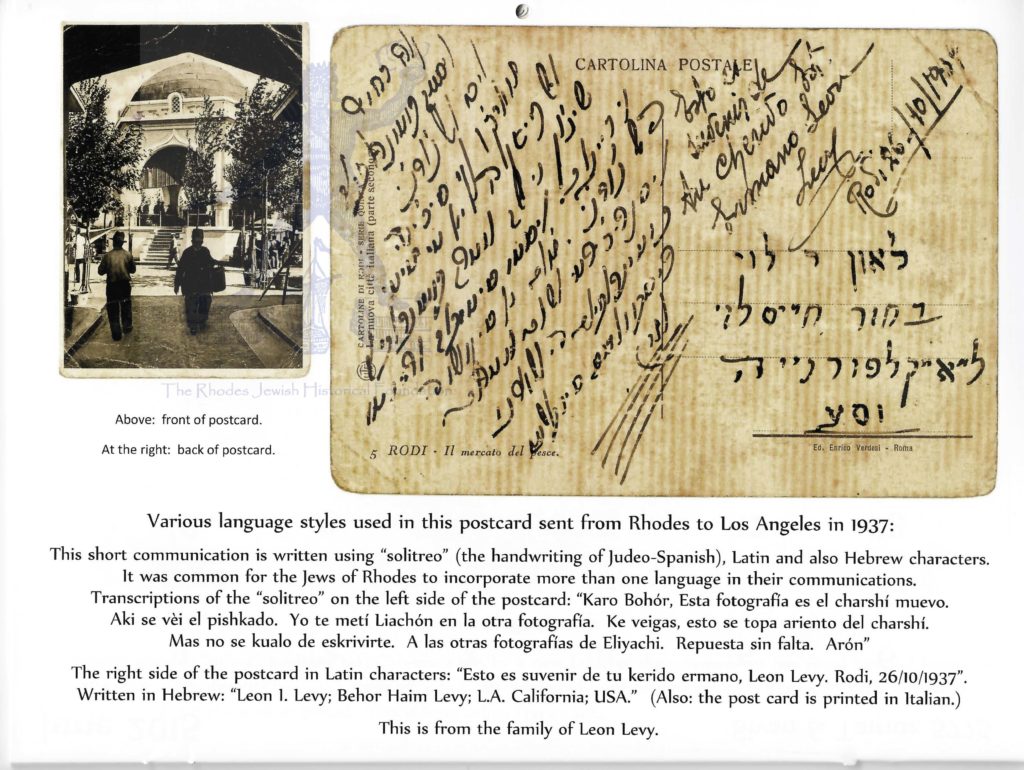
Various language styles were used in this 1937 postcard written by Leon Levy from Rhodes sent to Los Angeles.
Images of La Kaye Ancha
Circa 1910 La Kaye Ancha
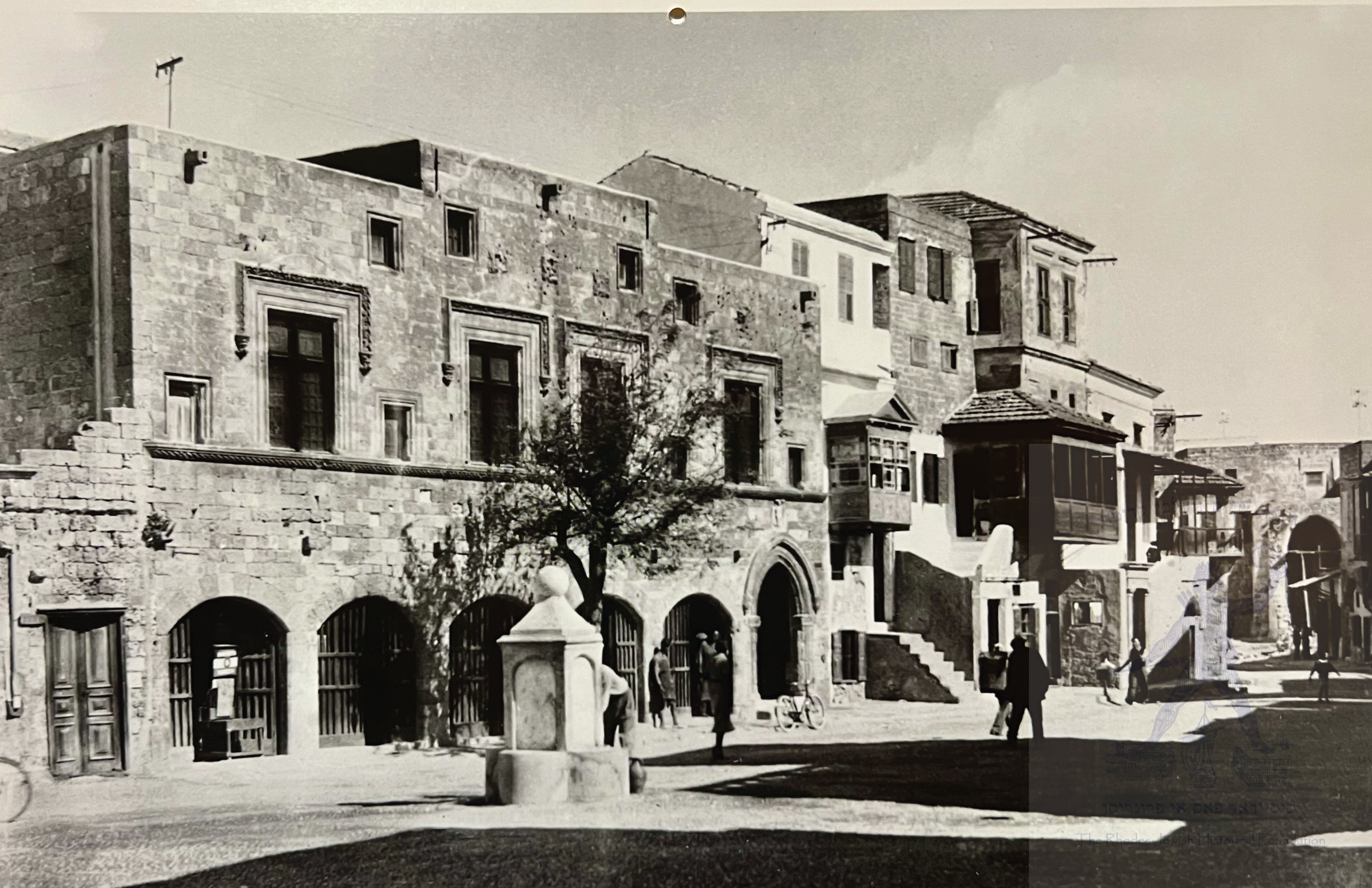
La Kaye Ancha with the old fountain
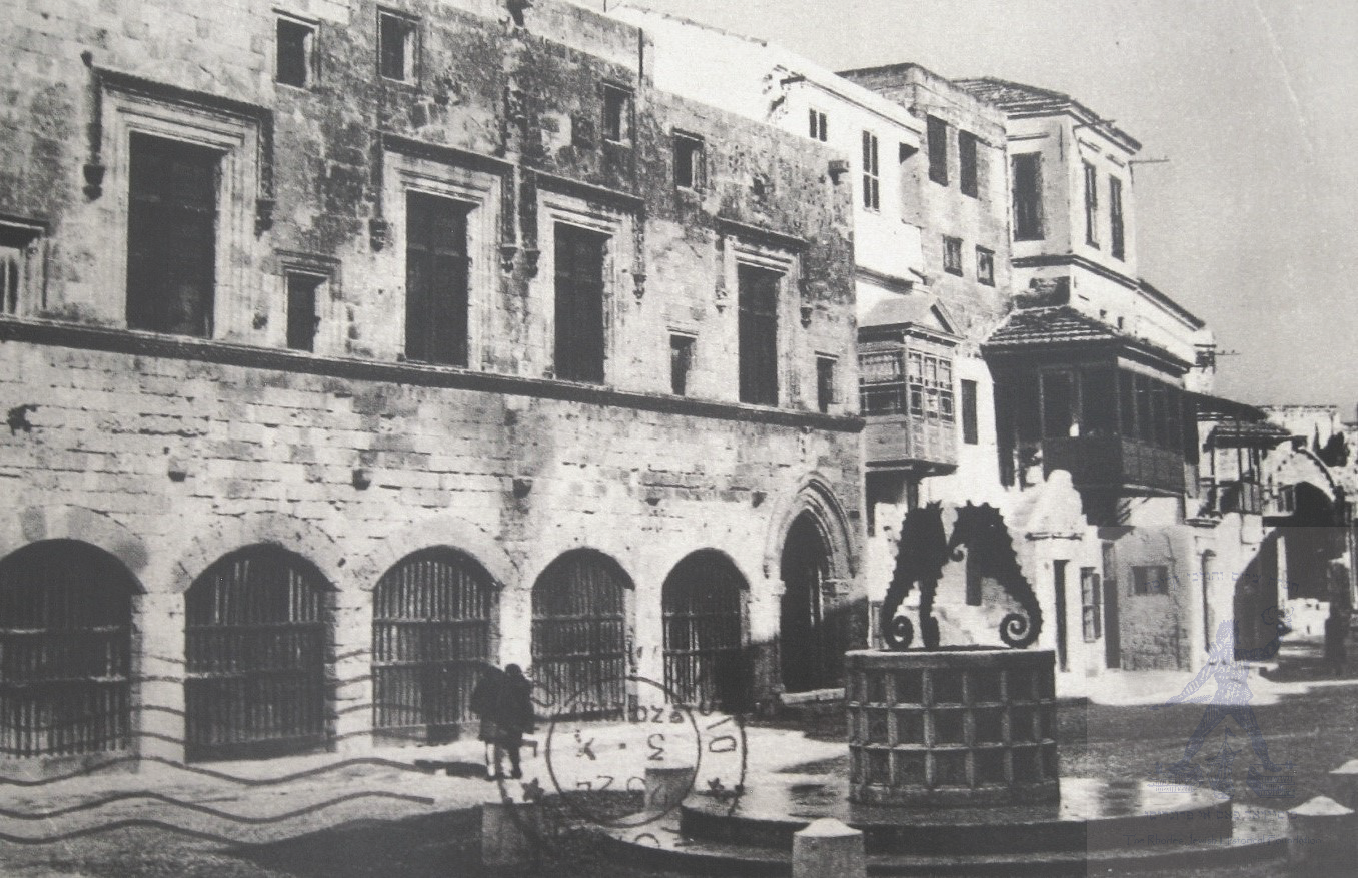
The old fountain was later replaced by the seahorse design that still exists today.
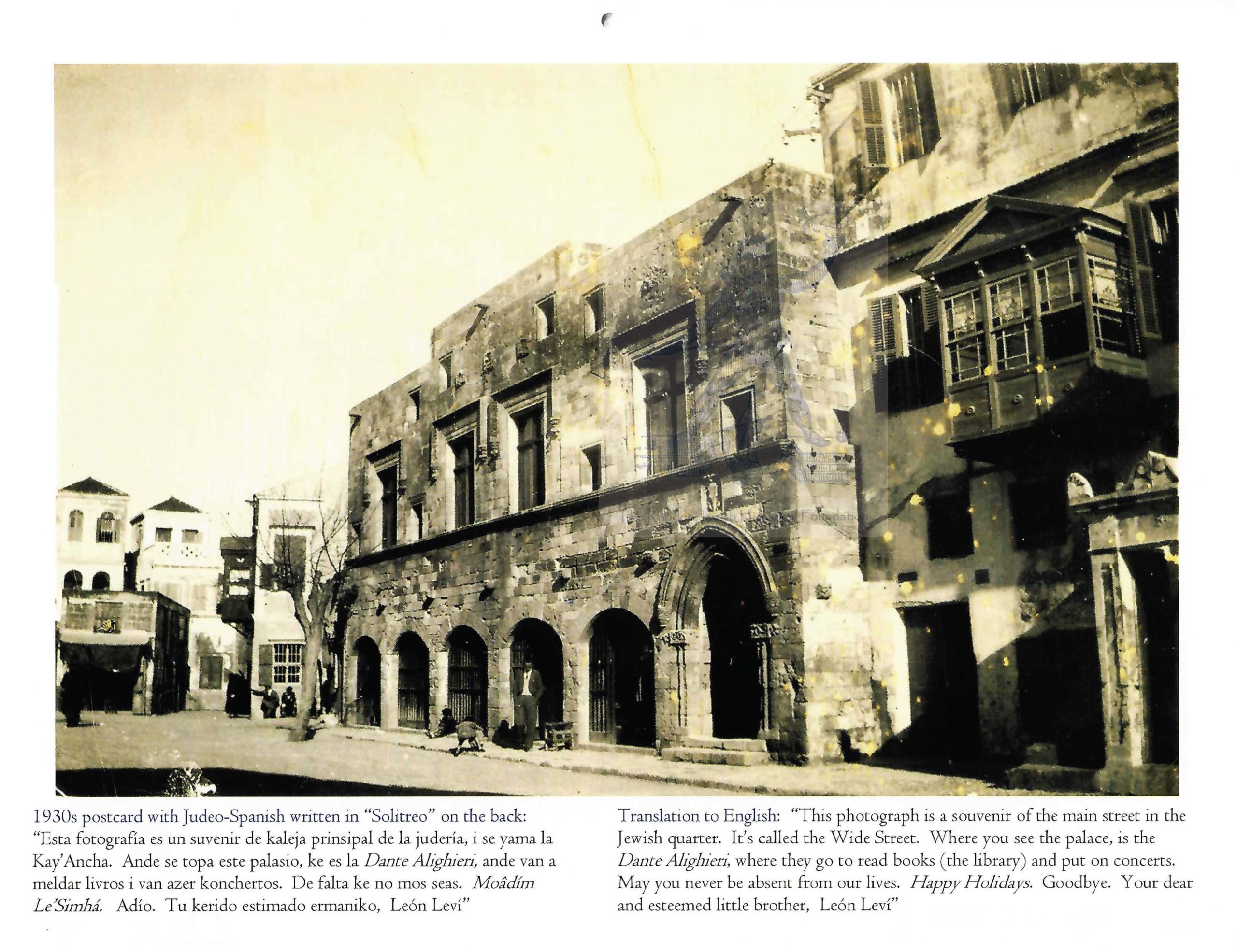
Another view of the main street.
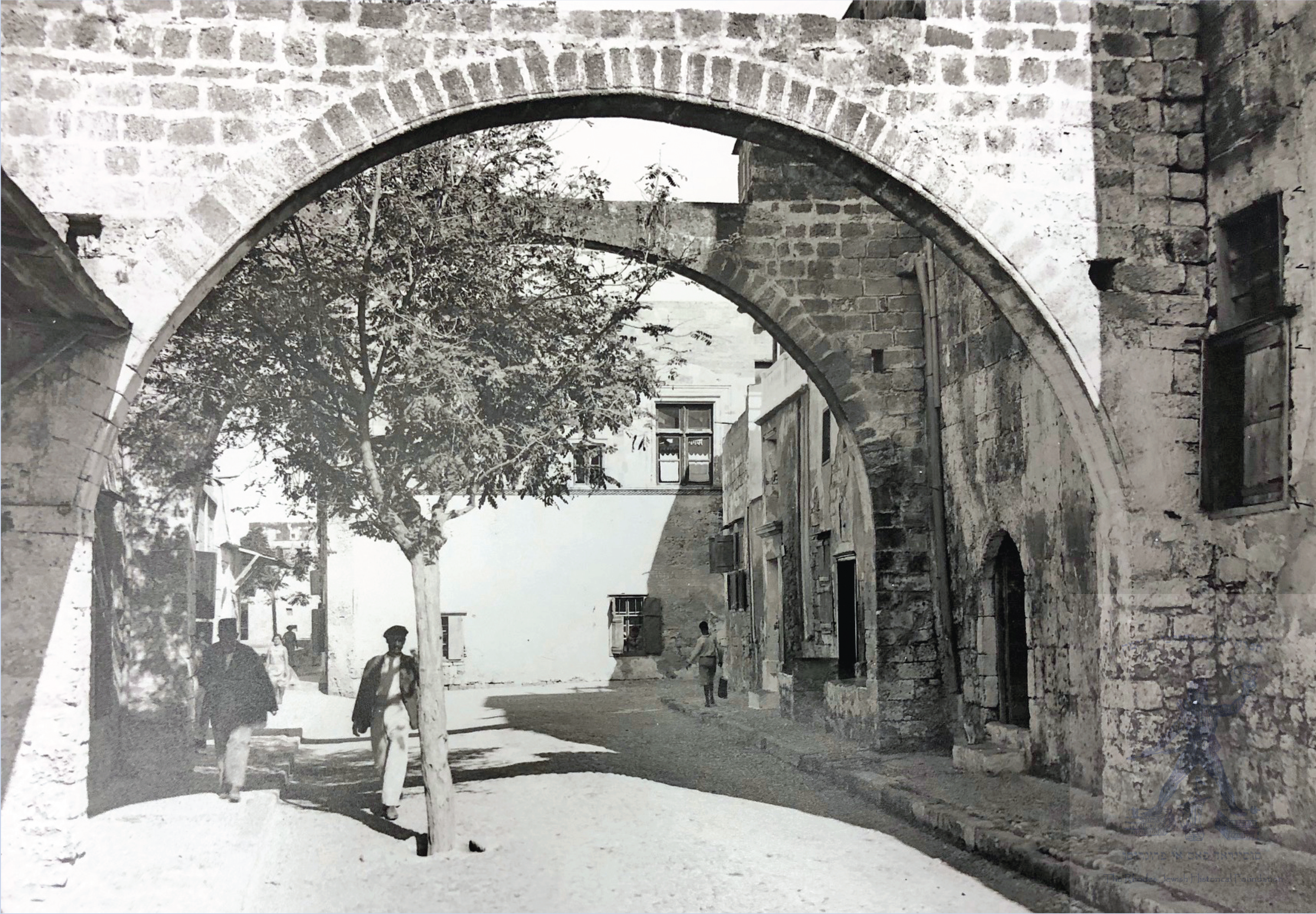
Located at the east end of La Kaye Ancha, the Rhodeslis called this street “el espejo” because it looked like a mirror.
Present Landmarks of the Jewish Community
Around the Jewish Quarter (historically known as “La Juderia”) there are several stone plaque monuments reminding us of the existence of Jewish life in Rhodes. The stone plaques which still exist today are written in Hebrew, Ladino, Italian and French. Many other landmarks have been destroyed by the bombings of World War II and by subsequent changes. Nevertheless, walking around the Old Jewish Quarter today still reveals several interesting landmarks (indicated on the map below).
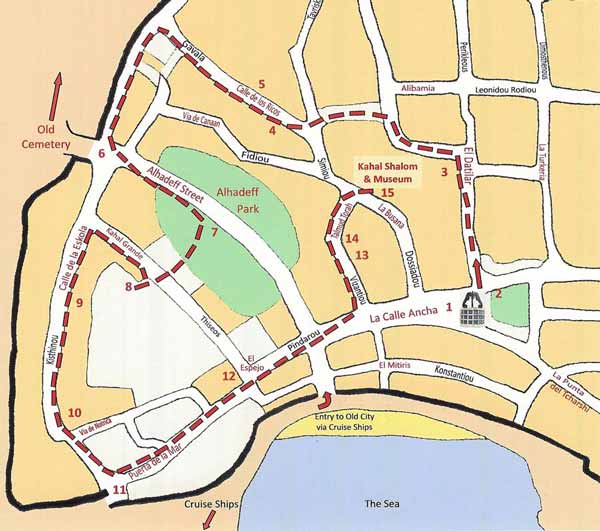
- Please Select a number on the map to read about the location
-
The “Square of the Martyred Jews”. Located at the end of “La Calle Ancha“.
The street called “La Calle Ancha” was the heart of the Jewish Quarter and was situated where the residential area ended and the business district started. The main street was known for hundreds of years as “La Calle Ancha” which means “the wide street” in the Judeo-Spanish (“Ladino”) language. The present fountain ornamented with three seahorses replaced a previous fountain that was destroyed during World War II.
-
Holocaust Memorial; located in the “Square of the Martyred Jews”
The Holocaust Memorial was dedicated on June 23, 2002 in memory of the World War II victims from Rhodes and the island of Cos. The dedication of the black granite column was a culmination of several years of planning by the Greek government in collaboration with the Jewish Community of Rhodes.
The monument is six sided, each having a different language: Greek, Hebrew, English, French, Italian and Judeo-Spanish (“Ladino”). The memorial is inscribed with the words: “IN ETERNAL MEMORY OF THE 1604 JEWISH MARTYRS OF RHODES AND COS WHO WERE MURDERED IN NAZI DEATH CAMPS. JULY 23, 1944.”
-
Joseph Notrica Donation of 1915; located on the corner of Perikleous & Ikarou Streets
There are a few homes surrounding a courtyard that was donated by Joseph Notrica for the Jewish community. There are two plaques, one on each side of the corner.
Background information: Joseph Notrica was a prominent banker who had no children. The income monies received were designated to help the poor of the community, particularly for needy children. The courtyard has a prominent date palm tree, and it was known to the community as “El Datlar”.
-
Alhadeff Family Donation Plaque of 1935 in “Ladino” (Judeo-Spanish); located on Calle de los Ricos (#5 Gavala Street)
Background information: this property was donated to the Jewish Community of Rhodes by the well known Alhadeff family. The family previously lived in the building prior to its donation.
-
Kahal Tikkun Hazot Synagogue; located on Calle de los Ricos (#8 Gavala Street)
The “Tikkun Hazot” was built in the 1870’s and the name comes from the “midnight service” and refers to the services before dawn.
Background information: It is situated on the street known in Judeo-Spanish (“Ladino”) as Calle de los Ricos, because the wealthier people lived on that street. The synagogue was therefore informally called “Kehila de los Ricos” because it was attended by the wealthier families of the Jewish community. -
Old Jewish Cemetery; located just outside the wall of the Old City
The cemetery existed there for hundreds of years until 1938, when it was forced to be moved by the Italian fascist government to its present location 1½ kilometers (1 mile) away.
-
Alhadeff Park; located in the central part of the Jewish Quarter
This park cross-sects (intersects) a main part of the old Jewish Quarter. The street running through the park is called Salomon Alhadeff Street. In 1933 the land was donated to the city of Rhodes by the prominent Jewish family of Salomon Alhadeff.
-
Kahal Grande Synagogue; located between Calle de Kahal Grande and Calle de la Escola (between Thiseos & Kisthinou Streets)
The full name of the synagogue was the Kahal Kadosh Gadol (the Holy Great Congregation) and was also called Kehila Grande in Judeo-Spanish (“Ladino”). During World War II the synagogue was accidentally damaged by Allied bombings targeting German ships docked at the nearby port.
The remains of the Kehila Grande, including the perimeter, floor and other features can still be seen. The synagogue is believed to have been built in the late 1400’s after the Turkish siege of 1480. It actually replaced an existing Jewish synagogue that was built earlier but destroyed by cannon balls during the conflict of 1480.
Although heavily damaged in 1944 during World War II bombings, the structural walls of the Kehila Grande synagogue remained standing for several more years. During the next thirty years, the walls collapsed and the area filled with rubble. In 2003, the Greek government cleared away the 4 feet of debris which had accumulated exposing the foundation of the perimeter walls, floors and other features.
-
1904 Dedication Plaque of the Alliance Israelite Universelle School; located in the center of Calle de la Escola (Kisthniou Street)
The dedication plaque above the fountain of the Jewish school of Rhodes is all that exists today. The large two story building was damaged during the bombings of World War II and eventually came down during the 1960’s.
Background information: During an August 1903 visit to Rhodes, the Baron and Baroness Edmond de Rothschild donated 15,000 francs to build the school. The school building was completed at the end of 1904. During the Italian occupation, the school changed its name to “Scuole Israelitiche Italiani“. Different from previous schools in Rhodes, the Alliance school was attended not only by boys, but girls as well. Included in the entryway is a 1913 inscription that recognizes the beneficial deeds of the Italian regional administrator.
-
Notrica Foundation Community Building; located at the north end of Calle de la Escola (Kisthiniou Street)
Established during the 1920’s this building was used as a Jewish community center for several purposes. This building was donated by the Joseph Notrica Foundation to the Jewish Community of Rhodes. It is now a Greek school.
Background information: As explained by Heskia Franco, in his book the Martyrs of Rhodes and Cos: “The Jewish Community had a fine building, called the Notrica Foundation, a Foundation which was established thanks to the generosity of Joseph Masliah Notrica, our great benefactor. The ground floor was used for overflow classes from our school which was next door. The upper floor housed the Community’s offices and those of the Bene Brith Association, and a vast hall was used for lectures, and also as a meeting place for all Community activities.”
At the top left facade is a white plaque with the inscription (translated from Greek): “Establishment of Joseph Notrica”.
-
“Puerta de la Mar“; located in the northeast corner of the Old City
Translated from Judeo-Spanish (“Ladino“) “Door to the Sea”. This was a relatively small gateway to the sea and was situated in the northeast residential area of the Jewish Quarter.
-
The Rabbinical College; located at the end of La Calle Ancha
In 1928 the Rabbinical College was established as the natural need for the development of a center for spiritual learning. The school attracted professors and students from several countries and earned an international reputation. Its graduates have played important roles in several Jewish communities.
During that time it had 4 locations. The first two locations of the Rabbinical College were located in the Old City of Rhodes in the Jewish Quarter while the second two premises were located in the New City of Rhodes. For a few years (approximately 1929 to 1932) the Rabbinical College was temporarily housed in a building built by the Crusaders, the Hospice of Saint Catherine. This is at the end of “La Calle Ancha” as it was known to the Rhodeslis and this part of the street was called “el espejo” in Ladino (Judeo-Spanish) because it looked like a mirror.
-
Plaque of 1767; located in the middle of Calle de Talmud Torah (#4 Vizantiou Street)
The small white tablet is located above a doorway located close to the Kehila Midrash synagogue. In this small room was where the community coffins were kept.
Translation from Hebrew: “With a good sign, this 8th day, month of Nisan, year 5527 (1767) from creation of the world.“
-
Kahal Midrash Synagogue; located in the middle of Calle de Talmud Torah (Vizantiou Street)
The Kehila Midrash was built in 1865 by the wealthy Camondo family from Constantinople (Istanbul). It was located upstairs and is the vault area above the street. It is currently a residence.
Background information: it was built with money donated by the wealthy banker, Abraham Camondo. It became known as a synagogue which had shorter religious services than other synagogues.
-
Kahal Shalom Synagogue & the Jewish Museum of Rhodes; located on Calle de Kahal Shalom (Simiou Street)
The Kahal Shalom, also known as the “Kehila Shalom“, is the oldest synagogue in Greece, and the sole remaining Jewish synagogue on Rhodes used for services. The Kehila Shalom is believed to have been built in the year 1577. The full name of the building is Kahal Kadosh Shalom (the Holy Congregation of Peace).
The interior of the Kehila Shalom synagogue follows the traditional Sephardic style of having the “tevah” (the prayer reading table) in the center of the sanctuary facing southeast toward Jerusalem. There is also a balcony that was created in 1935, as a result of a liberalization of religious policy, to be used as a women’s prayer area. Prior to that time the women sat in the rooms adjacent to the south wall of the synagogue that viewed the sanctuary through curtained openings. Those rooms are now being utilized for the Jewish Museum of Rhodes.
Location of Jewish Family Homes
Many Rhodesli descendants are interested in learning the location of their family home in the Jewish Quarter, also known as “La Juderia.” Therefore, the following five maps have been created to provide that information, despite 70 years having elapsed since the War and many homes destroyed in bombings.
Thanks to the former residents of Rhodes, they have recalled these locations during the decade up to the 1944 deportation. The primary sources are Joseph D. Alhadeff, Stella Levi, Sylvia Hasson-Berro, Diana Galante Golden, and Sara Hanan Gilmore. Other sources include Albert Almeleh, Rosa Israel Ferera, Joseph Natan Hasson, Sami Modiano, David Galante, Albert Menashe, and Morris Barkey.
This “location of homes” project is ongoing. Therefore, if you can share information regarding your family home, please forward it to us so we can try to corroborate it for inclusion when the maps are updated. We hope you enjoy this remarkable insight into how tight-knit this unique Jewish community was.
*Notice: Use the information on the maps as additional guides. Total accuracy is not possible since some families changed homes, including business locations during that period.
Family homes around the Calle Ancha:
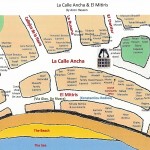 List-of-families-around-La-Calle-Ancha-El-Mitiris
List-of-families-around-La-Calle-Ancha-El-Mitiris
Family homes around the Kahal Shalom synagogue:
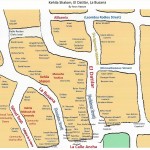 List-of-families-around-Kehila-Shalom2
List-of-families-around-Kehila-Shalom2
Family homes around La Fasana:
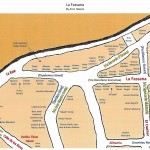 List-of-family-homes-around-La-Fasana
List-of-family-homes-around-La-Fasana
Family homes around Calle de Los Ricos:
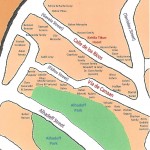 list-of-families-living-on-Calle-del-los-Ricos-on-Via-de-Canaan
list-of-families-living-on-Calle-del-los-Ricos-on-Via-de-Canaan
Family homes around the Kahal Grande synagogue:
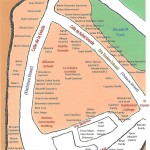 List-of-families-around-Kehila-Grande-Alliance-School-Puerta-de-la-Mar
List-of-families-around-Kehila-Grande-Alliance-School-Puerta-de-la-Mar
Location of Jewish Businesses
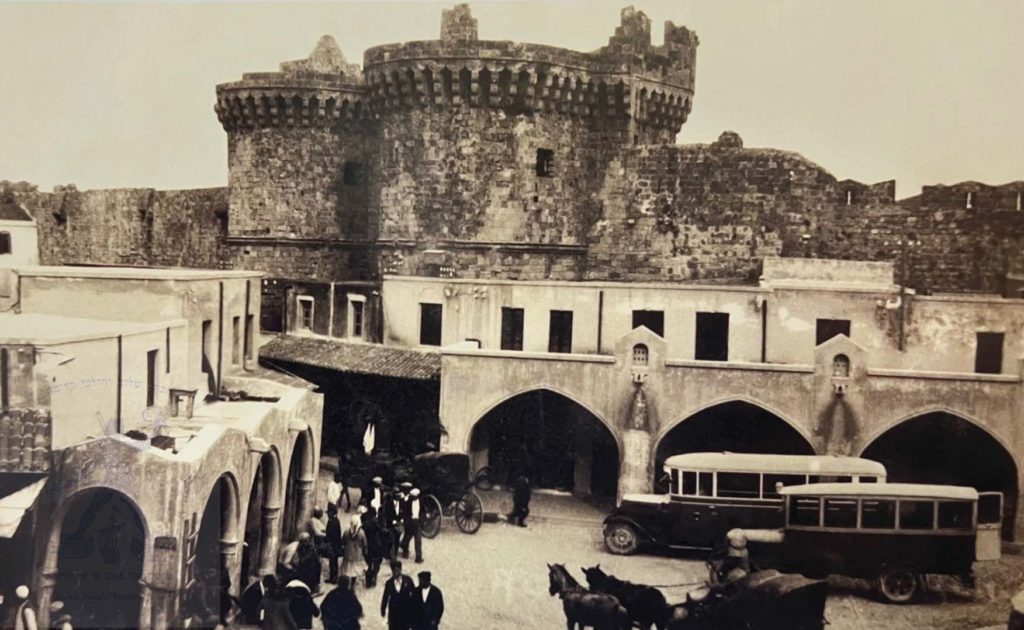
Circa 1920s of Piazza del Fuoco or “El Charshi Kemado” with the view of the Marine Gate.
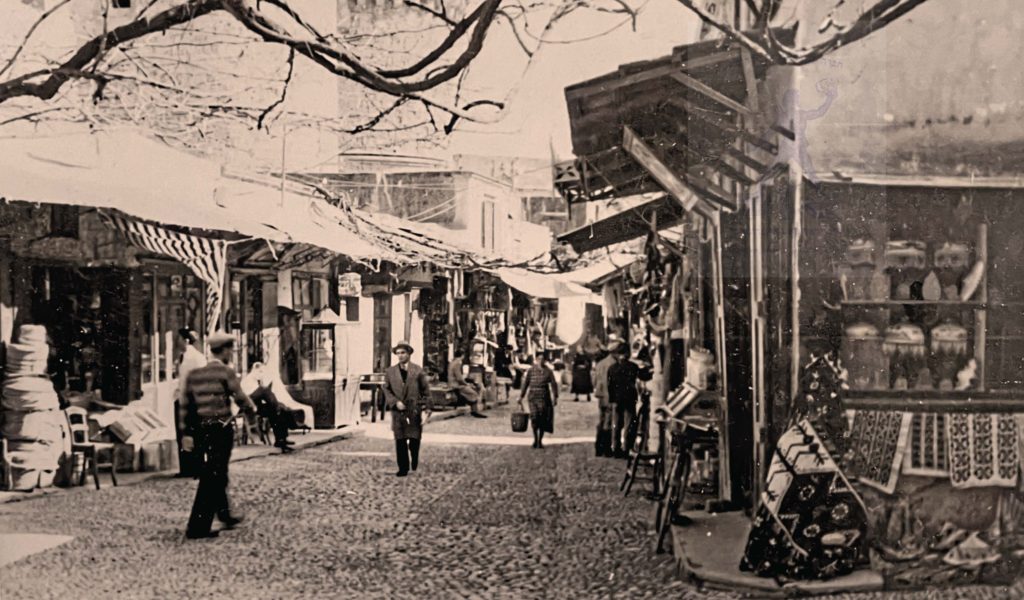
Shops in La Juderia near the hamam (Turkish bath) with the Marine Gate in the background.
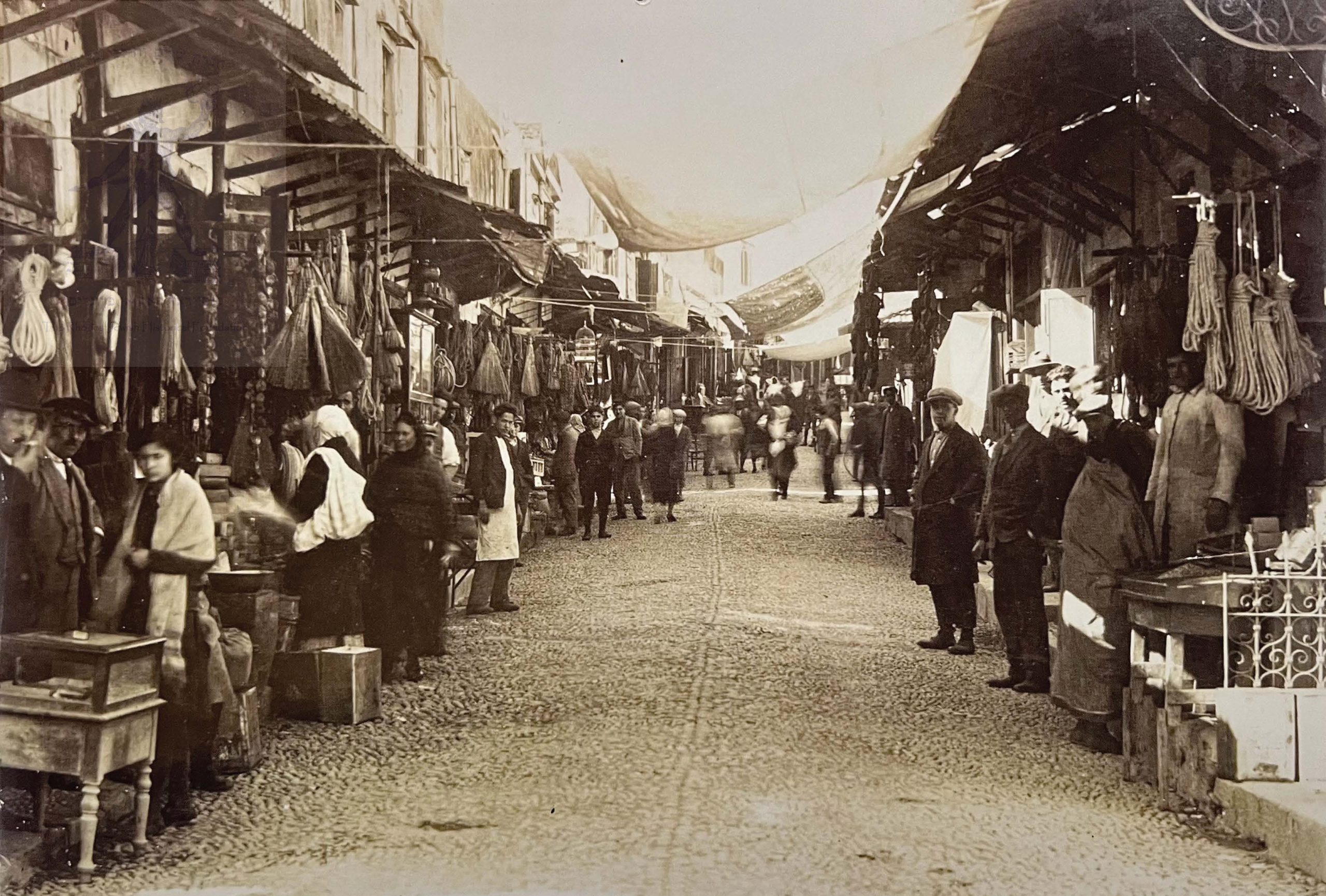
Circa 1915 of Jewish Shops in Arriva del Kadi (now Sokratous Street).
The business street used to be called “Arriva del Kadi” by the Jewish community of Rhodes and is now known as Sokratous Street. “Kadi” means “Ottoman authority” or “Ottoman official”. It is a long street that connected two sections: the Jewish business section which was located at the lower end and the Ottoman business section on the upper end of the street. The upper Ottoman district included the Turkish authorities, the Turkish library and Soleiman’s mosque.
4 Views of the Business Square in the Old City of Rhodes
Most visitors to the Old City of Rhodes do not realize the extent of the Jewish presence that existed before the War. This main business square was previously known as “Tcharshi Kemado” and “Piazza del Fuoco.” Many landmarks are now gone making it challenging to appreciate what existed. Therefore, to help people learn of this history, I have prepared these photos indicating the types of businesses and the owners’ names during the 1930s. Thanks to Joseph D. Alhadeff of Brussels, who lived in Rhodes, was the primary source of this information.
*Notice: Use the information on the maps as additional guides. Total accuracy is not possible since some families changed homes, including business locations during that period.
1930s Jewish businesses, North Side
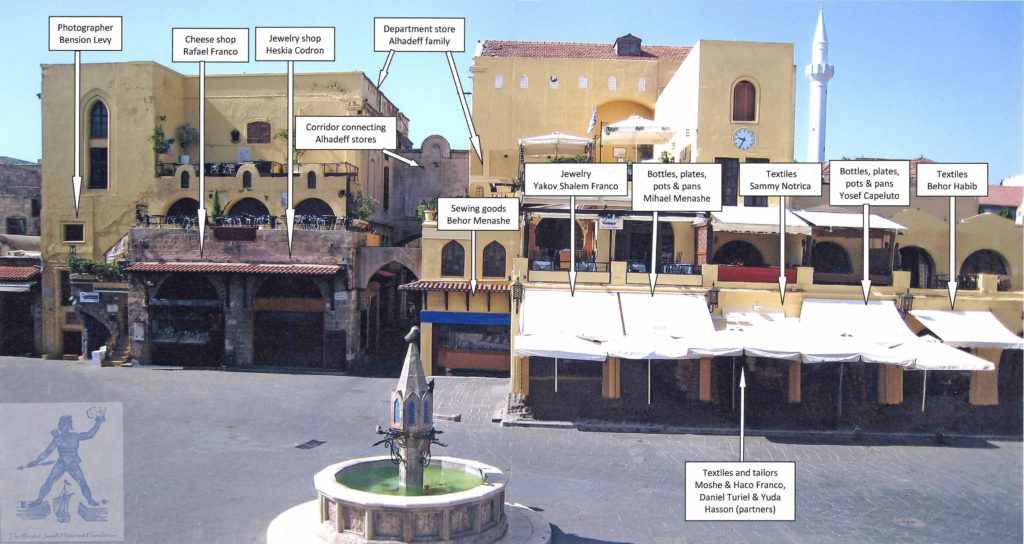
1930s Jewish businesses, South Side
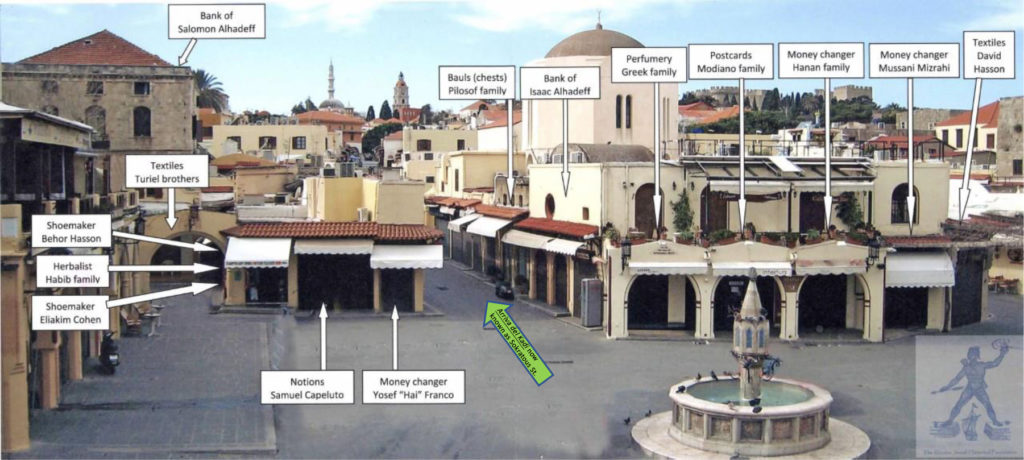
1930s Jewish businesses, West Side
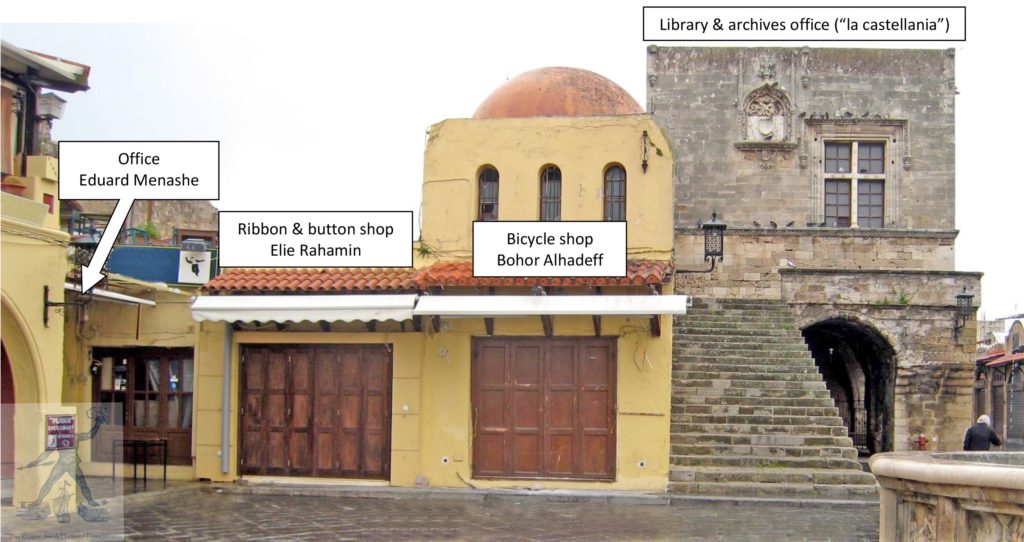
1930s Jewish businesses, East Side
Images of Jewish Landmarks
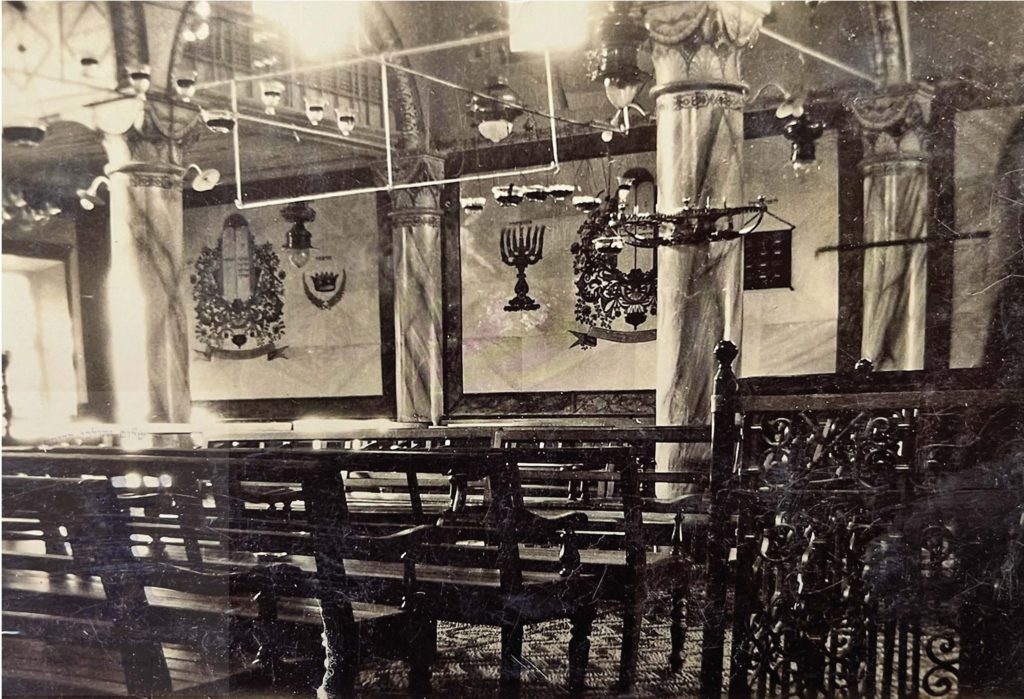
1930s Interior of the Kahal Shalom (Kehila Shalom).
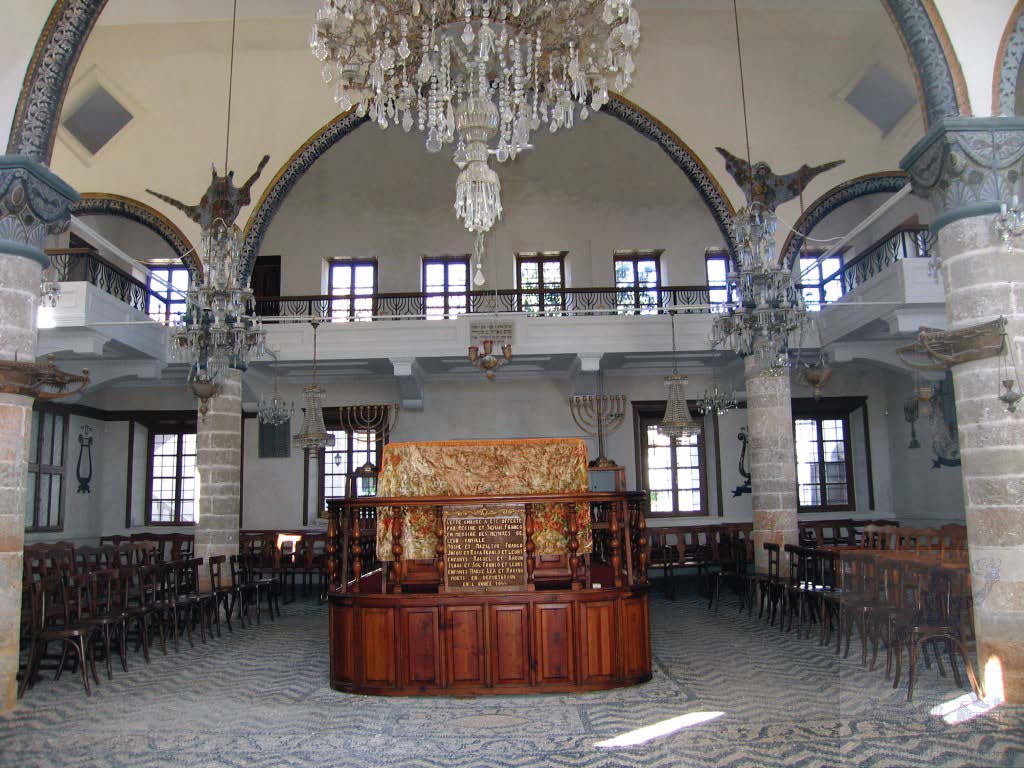
Kahal Shalom
The Kahal Shalom, also known as Kehila Shalom, is the oldest synagogue in Greece and the sole remaining Jewish synagogue on Rhodes used for services up to this day. The synagogue was one of the four synagogues (plus two oratories) in the Jewish Quarter. The Kahal Shalom is believed to have been built in the year 1577. The full name of the building is Kahal Kadosh Shalom (the Holy Congregation of Peace).
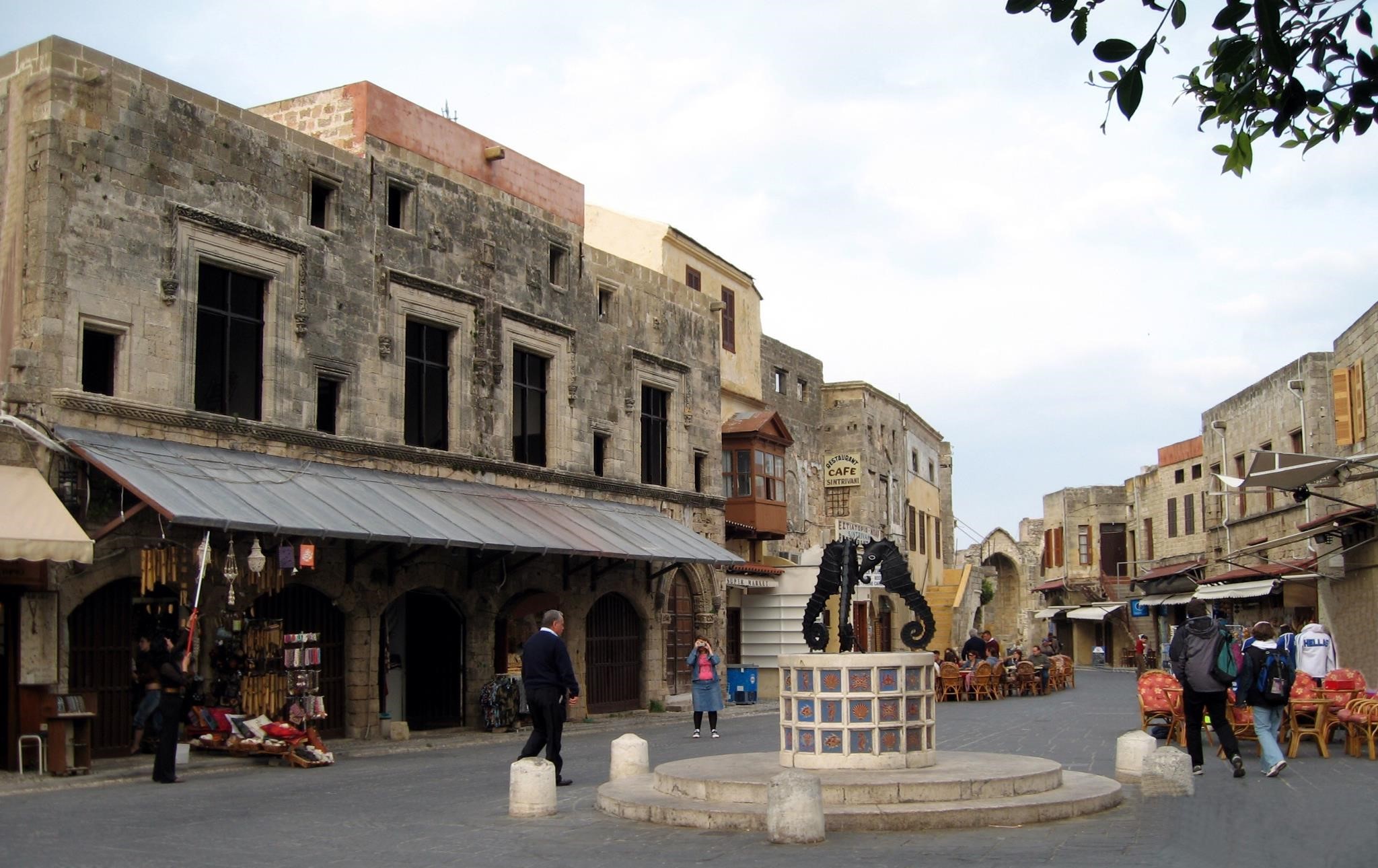
La Kaye Ancha (means “the wide street”)
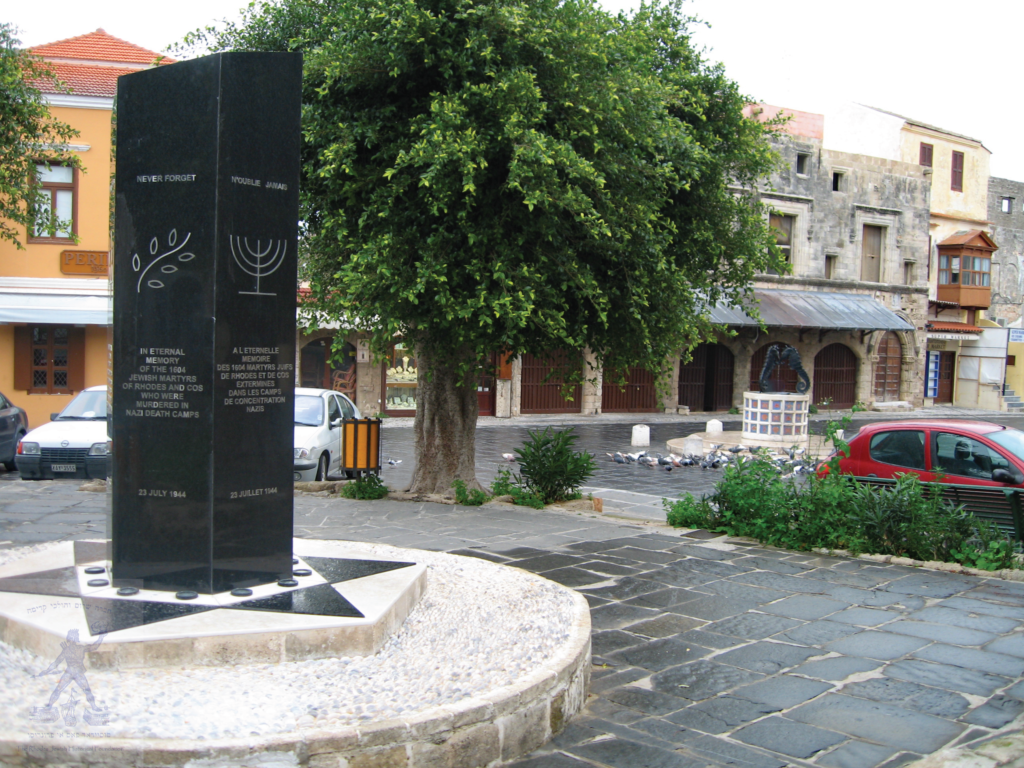
The Square of the Martyred Jews
The “Square of the Martyred Jews” (known in Greek as “Martyron Evreon”) is located in the heart of the former Jewish Quarter. The square’s present park was initially an area of Jewish homes and small shops. However, this sector was bombed during World War II, and in its place, a small park and square were established. The present fountain is ornamented with three seahorses.
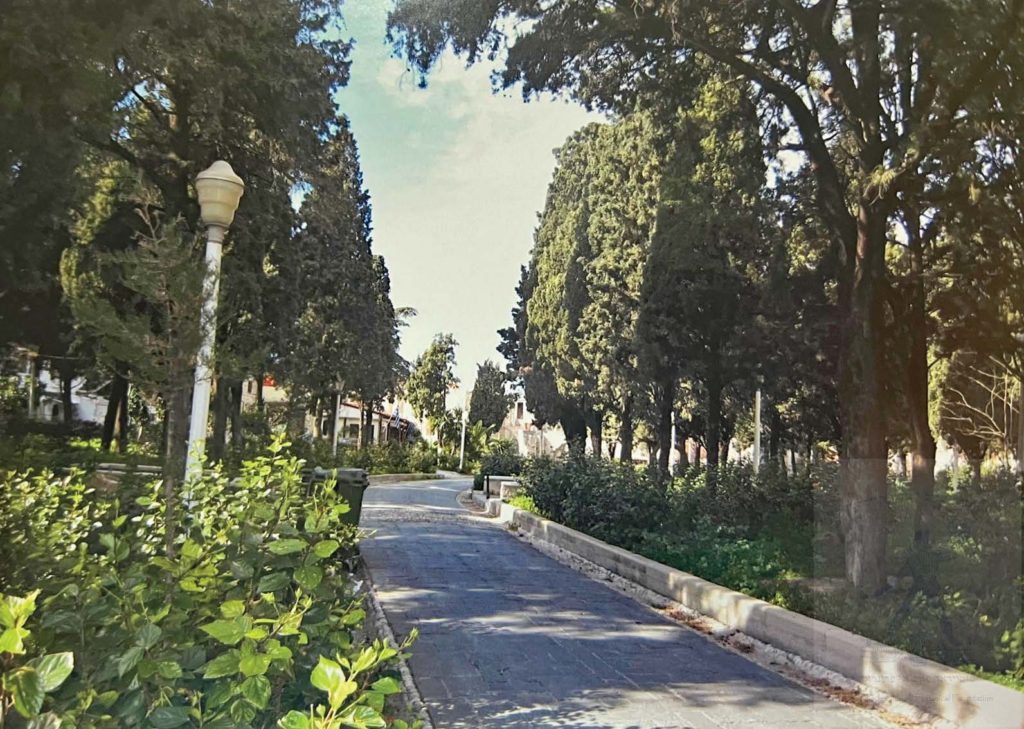
Alhadeff Park
This park cross-sects the heart of the Old Jewish Quarter. The street running through the park is called Salomon Alhadeff Street.
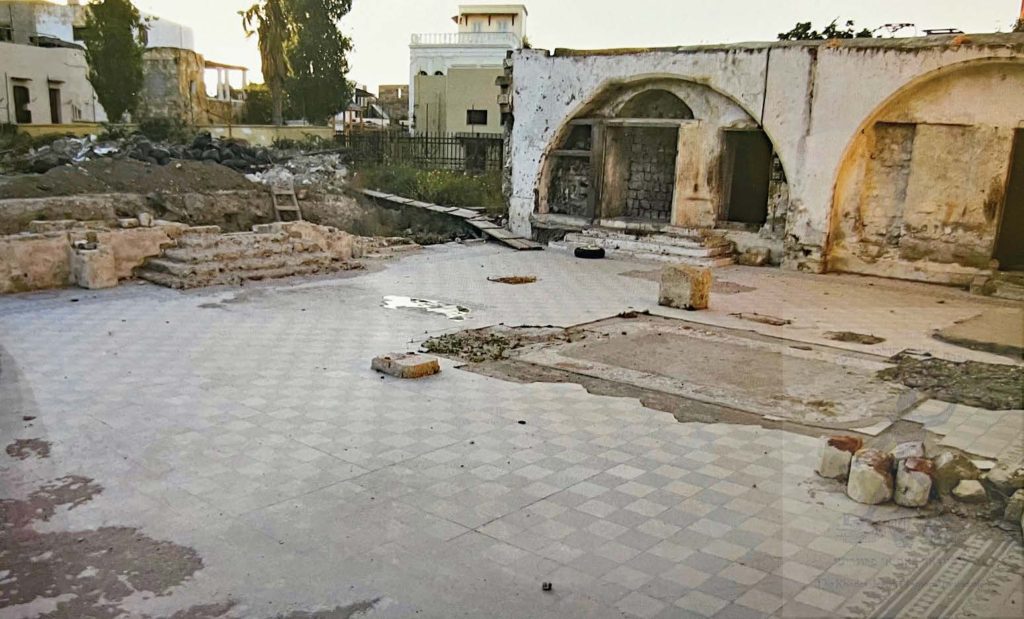
Kehila Grande (“Kahal Gadol”)
The remaining floor and one of the walls of the Kehila Grande (Kahal Gadol). On the floor in the center right is the rectangular foundation of where the “teva” (prayer reading table) was located. During WWII, the synagogue was accidentally damaged by the Allied bombings targeting German ships docked at the nearby port.
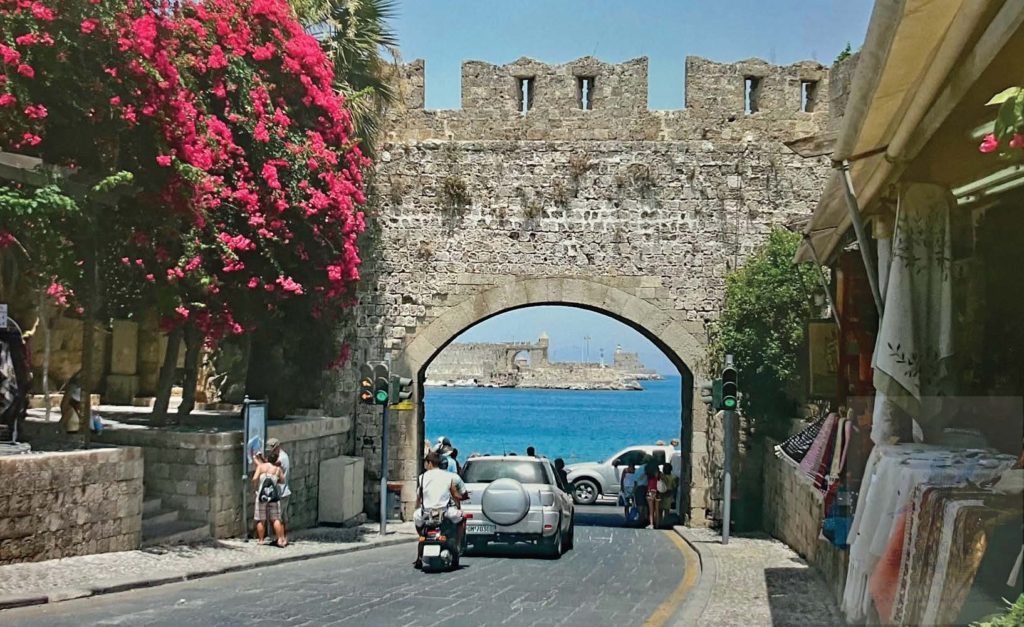
Entry to the Jewish Quarter
This is one of the entries to the Jewish Quarter most frequently used by visitors from the cruise ships.
Jewish Cemetery
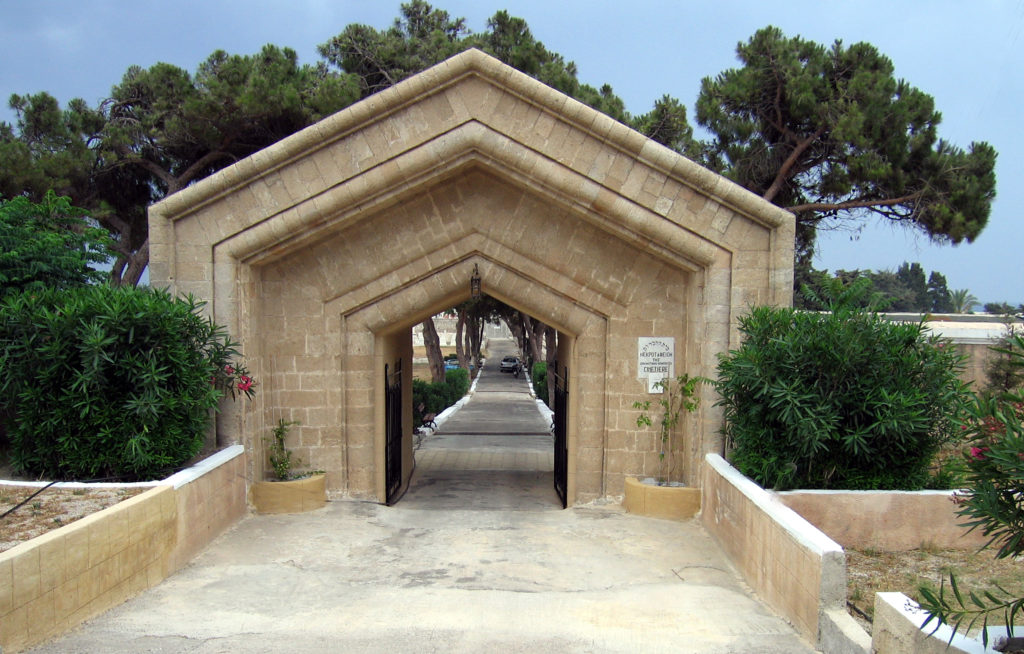 The Jewish Cemetery is one of the best-preserved in Europe and contains tombstones from the 1500s to the present. The excavations of tombstones from 1997 to the early 2000s uncovered hundreds of ancient burial stones.
The Jewish Cemetery is one of the best-preserved in Europe and contains tombstones from the 1500s to the present. The excavations of tombstones from 1997 to the early 2000s uncovered hundreds of ancient burial stones.
The cemetery is located outside the Old City of Rhodes along the main road to Kallithea. It’s a 10-minute drive from the Old City, and a taxi station is just outside the Jewish Quarter next to the “Marine Gate.”
For information about the tombstones go to: The Jewish Cemetery of Rhodes
Personal Walking Tours of the Jewish Quarter by Isaac Habib
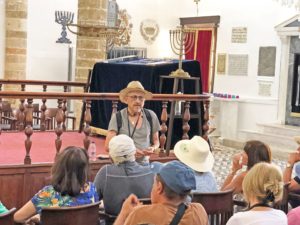 We are fortunate to have the services of Isaac Habib to provide tours of the synagogue, museum, and the Jewish Quarter of Rhodes. Isaac lives in Cape Town and has a wealth of knowledge and sentiment for the history of “La Juderia” from the Jewish perspective (his family lived in the Jewish Quarter of Rhodes before the Holocaust). Isaac is a poet in Judeo-Spanish (“Ladino”), the ancient language of the Sephardic Jews who lived in Rhodes.
We are fortunate to have the services of Isaac Habib to provide tours of the synagogue, museum, and the Jewish Quarter of Rhodes. Isaac lives in Cape Town and has a wealth of knowledge and sentiment for the history of “La Juderia” from the Jewish perspective (his family lived in the Jewish Quarter of Rhodes before the Holocaust). Isaac is a poet in Judeo-Spanish (“Ladino”), the ancient language of the Sephardic Jews who lived in Rhodes.
Read: Poemas i Pinturas de Isaac Habib
*Notice: Please note that the tour schedule is subject to change based on availability, holidays, etc. For inquiries and to schedule a group visit tour, please contact: jcrhodes@otenet.gr or telephone: +30 22410-22364.
For more info, see the FAQs.
For reference: A Guidebook to the Jewish Quarter of Rhodes, see Giftshop.
*Images are from the Rhodesli Jewish Calendars and RJHF Archives

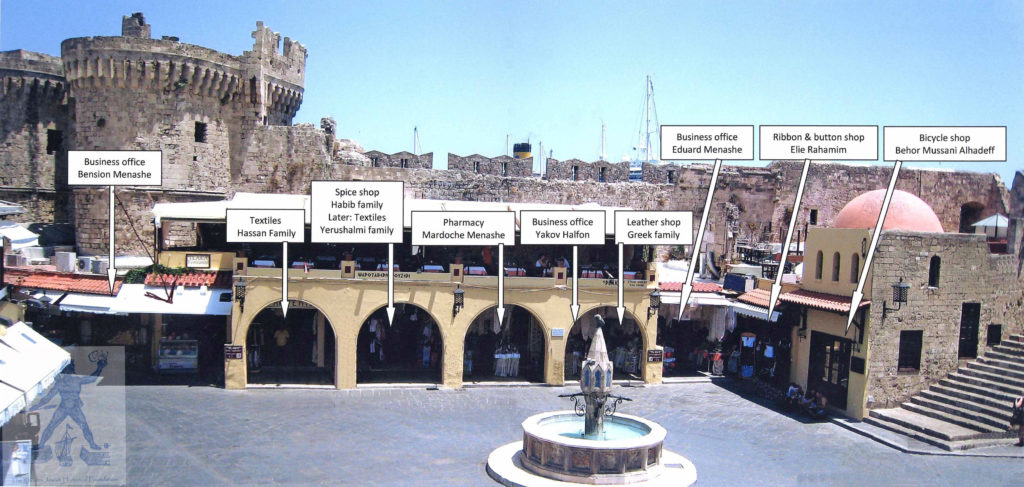
If it hasnt been mentioned already, the photo above showing the entrance to the Jewish quarter was referred to as “la puerta de la mar” (the exit to the sea). My father recalled they used to exit there from the old city out to the beach area where his uncle had a cabana type cabin. They used to go to the beach and stay and sleep there right at the beach in those days.
In Rhodes during the 1920s, Hanukah was celebrated with relatives and friends as they would gather for a picnic called “el dia di la Miranda.” Burmuelos, a deep-fried dough covered with honey and or sesame dip, were served. The Hanukiah that was used was made of tin and lightened using wicks placed in small oil containers. (I Remember Rhodes by Rebecca Amato Levy)
1906 Rhodes Hanukia made of tin from the Bellina Hasson Gold Family, Los Angeles
in rodos now through June 3. I hope to hear from whoever is here.
hello and thank you so much for all the photos and information. I would love to visit rhodes!
My grandfather was morris Cohen and immigrated to Seattle as a young man from rhodes. His parents were Nissan Cohen and median alhadeff. I recognize many of the names mentioned here. I do have at least one good photo from Rhods if you’d like to see it. My grandfather was a tailor in seattle. Anyone know if his father, Nissan was also a tailor. Also looking for the address where they lived.
@dario My great grandmother was Galante (Caterina) and I know she had many brothers and sisters. We might be related.
Hello Gilda Mayo. My great grandfather was Mordechai Mayo. He was the brother of your great grandfather David Mayo. Their father’s name was Jacob Mayo/De Mayo. Part of your family settled in Los Angeles. Please contact me if you would like more information. Aron Hasson knows my contact information.
Sincerely,
Your second cousin,
Bob Rubin Mayo
Hablo espanyol.
Gilda: The “Cemetery” page indicates that a David Mayo died in 1920. Based on your information that your great grandfather David Mayo was born in 1837, then the person buried in 1920 would have died at the age of 83. Translating that tombstone indicates that David was the son of Jacob–they are both located next to each other in Row 11: number 19 and 20. Therefore, if this is your great grandfather, then Jacob would be his father. If you fully translate these two tombstones they may indicate what their occupations were. Good luck.
Hello!! I’m building my genealogical tree and please I need your help. My grandfather was born in Rhodes in 1893, his name was Bension Mayo. I know that my great grandfather was David Mayo (born in 1837?) and his wife (my great grandmother) was Matile Pizante (born in 1860?) Since my grandfather left the island and arrived to Buenos Aires around 1911, I don’t know what had happened to their parents and if he had any siblings also, what had happened to them. I`m also interested to know which was their occupation. I was looking in the “Cemetery” page for… Read more »
Aron,
My grandmother Juana Franco Habib, came here from her father’s home on the Calle de los ricos. (Avram Franco and Rosa Billi Franco.) Their home was other side of the street from the Kehila, and I believe near the Cohen families near where the road bends.
Hi. My father’s family is from Rhodes, his grand father tomb is still there. I know they had a bakery, and my father, who has been sent from Cairo to Rhodes probably twice in his early age between the 2 WW, knew where this bakery was and in early ’80s, during a trip there, was able to find the place, but as for many other things, he never wanted to share this with me and my sister. I suppose this bakery maybe was owned or managed by Rahamin Galante זל. Anyone have an idea where this Galante bakery could have… Read more »
Hi Paul. There was a Bension Rahamim Menasche who was a prominent businessman in Rhodes working for the Alhadeff Bank. In fact, he was honored with a medal from the Italian government for his commercial achievements and awarded the title of “Cavaliere della Corona d’Italia”. The original medal is on display at the Jewish Museum of Rhodes and a photo of it could also be viewed on the “Museum Archives” page of this website. The 1941 cover regarding one of the Slovakian refugees relates to the group who were temporarily held in the concentration camp on Rhodes in the Stadium… Read more »
Hi. I have two queries, I have a postcard of 1905 sent from the business of Bension R Menasche. Can you advise me the type of business and what became of this gentleman. My second query concerns a cover sent from Slovakia in 1941 to Dott. Lily Ickovic-Frischer / Campo Stadio. The addressee was on a boat that left Bratislava and ran aground on a Greek island. An Italian ship took all the Jews to Rhodes and they spent time in the Stadium. I understand that this woman was taken to Italy (internment camp)where she saw out the rest of… Read more »
Hi Bertie. There were 4 synagogues in Rhodes: Kahal Shalom, Kahal Gadol (aka Kahal Grande), Kahal Tikun Hazot and Kahal Midrash Kamondo. There were also other additional informal places of worship (rooms of family homes), such as the Franco and Hanan residences.
For a history of the Jewish cemeteries I recommend the book: “A History of Jewish Rhodes” by Esther Fintz Menasce which can be ordered on the “Giftshop” page of this website.
Dear Sir/Madam. I am doing a research on the synagogues in Rhodes and will be very interested in any information that you can send me about the 6 synagogues that existed in Rhodes. I also need information about the Jewish cemeteries and their history. Thank you very much for your help. I look forward to reading your response at your earliest convenience.
What a wonderful site! I am looking for members of the Soriano family – only three of them are mentioned in these household listings – and all I know are that the children were Nissim, Rebecca and Jenny. Would anyone know of this family, the father’s name and what he did. Rebecca and Nissim went to Congo in 1938? Thank you.
The synagogue & museum opens at 10am. I recommend that you arrive before 11am and inquire about the walking tour (usually starts at 12noon or 1pm).
My wife and I are visiting Rhodes on a cruise on October 14, 2018. We would like to visit the synagogue, the museum, etc. We are interested in having a tour, and possibly a walking tour of the Jewish area. Any suggestions?
My grandmother, Rosa Capuano Cadranel was born in Rhodes in 1852 and she had migrated to the US from Izmir (Smyrna), Turkey and landed at Ellis Island in 1913. My mother Belinda Cadranel came at that time with our whole family and married Hisquia (Max) Eskenazi on American soil. This was a pre-arranged marriage when she was born. She met him in New York for the first time and they married there. Both Belina and Hisquia were dress makers/tailors. My uncle Nisim Cadranel came to the US first and worked at the US Mint in Washington DC. He sponsored our… Read more »
To Sam Soriano. I just noticed that my Email address won’t be published. Therefore here it is … (email forwarded privately by aron to Sam)
This message is for Albert Palombo. I am your 1st cousin. My father was Simon born in
1897. Please send me your e mail address and telephone number so we may reconnect.
Sam Soriano